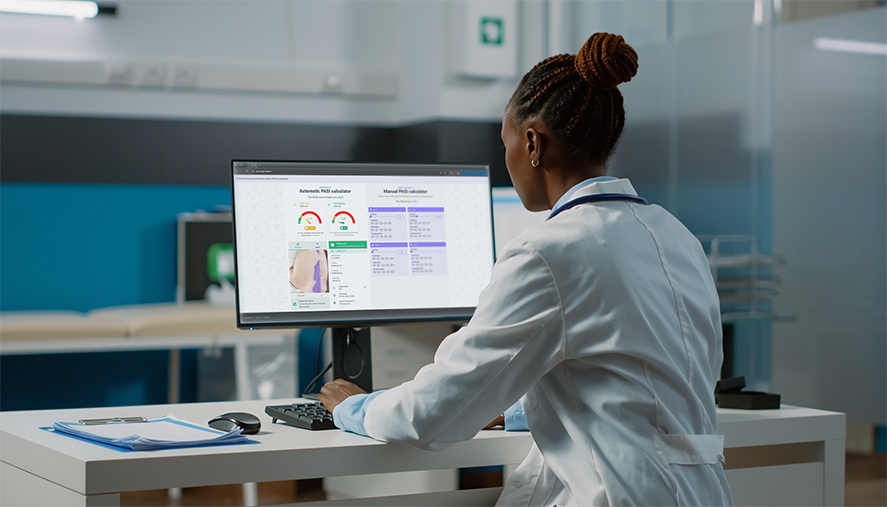APASI: The bright future of Psoriasis severity assessment has arrived
Introduction
Legit.Health presents a groundbreaking advancement in dermatological assessment technology: the APASI (Automatic Psoriasis Area and Severity Index) system. This innovative solution harnesses the power of artificial intelligence to analyze clinical images and automatically calculate standardized PASI scores, transforming how psoriasis severity is evaluated in clinical practice and research.
Using computer vision algorithms, our researchers have created a tool that processes smartphone images and automatically translates them into the domain of the PASI, providing objective, rapid, and precise evaluations that complement traditional clinical assessment methods.
The development and validation of APASI have been documented in a comprehensive scientific publication in JEADV Clinical Practice:
APASI provides a robust AI-driven framework for psoriasis severity assessment, delivering rapid, objective, and precise evaluations. Its integration into clinical and research workflows could enhance disease monitoring, improve treatment assessment and reduce evaluation costs.
We encourage you to read the whole publication.
Mac Carthy T, Dagnino D, Medela A, Fernández G, Aguilar A, Martorell A, Gómez-Tejerina P, Roustán-Gullón G. Artificial Intelligence-Based Quantification to Assess the Automatic Psoriasis Area and Severity Index. JEADV Clin Pract. 2025. https://doi.org/10.1002/jvc2.70143
Understanding the challenge in psoriasis assessment
Psoriasis affects approximately 125 million individuals worldwide, manifesting as erythematous plaques with silvery scales that significantly impact patients' quality of life. Despite the clinical visibility of psoriasis lesions, achieving consistent and objective severity assessments remains challenging.
The origins and limitations of PASI
The Psoriasis Area and Severity Index (PASI) was first published in 1978 by T. Fredericksson and U. Pettersson. Their formula for assessing the severity of the condition would go on to become the gold standard for dermatologists around the globe and is still widely used to this day.
However, traditional PASI assessment presents several critical limitations.
We found substantial variation [in the results] between experienced and inexperienced physicians using PASI
In other words, there is a high inter-observer variability, that is most pronounced when compared between experienced and inexperienced practitioners.
Aside from the inter-observer variation, many physicians have reported that filling up the paper sheet is too tedious and time-consuming and that they don't really use it on a day-to-day basis. This has led to the underutilization of PASI in clinical practice, despite its recognized importance in psoriasis management.
PASI score sheet by British Columbia Ministry of Health
Digital calculators: A half-baked solution
With the advent of basic computation, several digitalized versions of the PASI scoring system were developed in an attempt to reduce the time wasted in calculations. These online calculators tackle, although inefficiently, just one of the issues the traditional PASI has. While the formula is calculated automatically, the doctor still has to fill in the value for each parameter.
This not only still requires the time and attention of the physician, but does nothing to address the multiple issues of lack of objectivity and reproducibility within the PASI system.
How do we know if a scoring system is good?
When it comes to dermatological assessments, the effectiveness of a scoring system is paramount. But what exactly makes a scoring system reliable and useful? Through scientific consensus, several key factors have been identified that contribute to the robustness of these systems. Let's delve into these crucial elements:
- Ease of Use: This factor considers whether the system can be applied effortlessly within the constraints of time and financial resources. A user-friendly system is crucial for widespread adoption in clinical settings.
- Sensitivity to Change: An effective scoring system must be capable of detecting clinically meaningful changes over time. This sensitivity ensures that any progress or deterioration in a patient's condition is accurately captured.
- Interobserver Reliability: This refers to the consistency of the results when different observers use the scoring system. High interobserver reliability means different clinicians will arrive at similar conclusions, enhancing the system's credibility.
- Intra-observer Variability: This looks at the consistency of results when the same observer uses the scoring system multiple times. Low intra-observer variability indicates that the system provides stable results, irrespective of repeated assessments by the same clinician.
- Interpretability: A practical scoring system should provide meaningful qualitative interpretations of its scores, like categorizing the severity of a condition as mild, moderate, or severe.
These criteria not only ensure the scoring system's effectiveness but also its applicability and reliability in diverse clinical scenarios.
Adapted from "Methods and definitions to rate the quality of outcome measures". Schmitt, J., Langan, S., Deckert, S., Svensson, A., von Kobyletzki, L., Thomas, K., & Spuls, P. (2013). Assessment of clinical signs of atopic dermatitis: A systematic review and recommendation. Journal of Allergy and Clinical Immunology, 132(6), 1337--1347. doi:10.1016/j.jaci.2013.07.008.
The APASI Solution: Revolutionary AI-powered psoriasis assessment
APASI represents a breakthrough in dermatological care, seamlessly blending cutting-edge artificial intelligence with decades of clinical expertise. This innovative system transforms how healthcare professionals evaluate and monitor psoriasis, making the process more objective, consistent, and efficient than ever before.
Core capabilities
At its core, APASI excels in two critical aspects of psoriasis assessment:
-
Intelligent Lesion Detection: Our advanced AI system can identify and measure psoriasis lesions with remarkable precision, even detecting subtle changes that might be missed by the human eye. This capability ensures that no affected area goes unnoticed, leading to more comprehensive treatment planning.
-
Comprehensive Severity Analysis: APASI evaluates the three key indicators of psoriasis severity with exceptional accuracy:
- Erythema: Precisely measures the degree of redness in affected areas
- Induration: Accurately assesses the thickness of psoriatic plaques
- Desquamation: Evaluates the extent of scaling with remarkable detail
Do you want to see the clinical AI technology in action?
Evidence-based excellence: Validation through rigorous testing
Behind APASI's user-friendly interface lies a sophisticated AI engine that has been trained on thousands of clinical cases. APASI's capabilities aren't just theoretical - they're proven through extensive real-world validation. Our system has been tested against a comprehensive database of clinical cases, representing the full spectrum of psoriasis presentations.
This rigorous validation process, involving multiple expert dermatologists and thousands of clinical images, demonstrates APASI's reliability and accuracy in real-world clinical settings. What's truly groundbreaking is that APASI's performance matches or even exceeds that of experienced dermatologists in many aspects of psoriasis evaluation.
After 12 months using Legit.Health, in which we analysed the applicability of the tool at our hospital, we have drawn conclusions that help to propose a new care paradigm in the follow-up of psoriasis.

Six key advantages of APASI in clinical practice
APASI is designed to support healthcare professionals by automating the traditionally time-consuming and subjective PASI assessment process, enabling more objective evidence-based dermatology while improving patient care efficiency.
This means that the new version of this scoring system extracts data precisely and consistently, both during routine evaluations and clinical research. The improvement can be seen in the following table, which compares the performance metrics of the most common way of using scoring systems:
| Pen and Paper | Digital | Automatic (AI) | |
|---|---|---|---|
| Self-supervision | - | - | Perform diagnosis |
| Ease of use | ≈ 600 seconds | ≈ 420 seconds | ≈ 23 seconds |
| Sensitivity to change | 0 to 4 | 0 to 4 | 0 to 100 |
| Interobserver variability | Medium (20%) | Medium (20%) | Lowest (8%) |
| Intra-observer variability | High | High | Zero |
Table 1: comparison between different methods of scoring the severity of a disease. The automatic artificial intelligence-powered method performs better across most performance indicators.
Thanks to the deep learning algorithms, Legit.Health relieves doctors from the tedious manual calculation of scoring systems and allows the practice of a more objective evidence-based dermatology. Also, by using algorithms to measure dryness, lichenification, erythema, oozing, oedema, and many more signs, the tool can calculate visual signs in a more reliably and consistently.
1. Rapid and objective severity assessment
APASI delivers automated PASI scores in seconds from smartphone images, eliminating the tedious manual calculations that take physicians 6-10 minutes per patient. This efficiency gain allows clinicians to dedicate more time to patient care while ensuring consistent, standardized measurements across all assessments.
2. Human-comparable performance in visual sign evaluation
The MiT_b2 model achieved accuracies of 60.6% for erythema, 54.3% for induration, and 61.8% for desquamation—matching or exceeding expert dermatologist performance in certain aspects. The system evaluates all three key PASI indicators with consistent precision, providing reliable severity grading comparable to experienced clinicians.
3. Superior lesion segmentation accuracy
The Xception-multi model achieved an Intersection over Union (IoU) of 0.752, surpassing the expert dermatologists' IoU of 0.702. This exceptional segmentation performance ensures accurate identification of affected areas, critical for calculating the body surface area component of PASI scoring.
4. Enhanced reproducibility and standardization
APASI's algorithmic approach completely eliminates intra-observer variability, ensuring identical assessments of the same lesion over time. This consistency is crucial for monitoring treatment response and enables more reliable longitudinal tracking of disease progression in both clinical practice and research settings.
5. Valuable tool for clinical trials
By providing standardized, reproducible assessments across multiple sites and timepoints, APASI addresses one of the most significant challenges in psoriasis clinical trials: interobserver variability. The automated scoring enables more granular and reliable data collection, potentially improving the precision of efficacy measurements in pharmaceutical research.
6. User-friendly clinical interface
The integrated CAD system displays lesion segmentation overlays, severity scores, and longitudinal progression charts in an intuitive format. Clinicians can track APASI evolution over time, review visual sign intensities, and access comprehensive patient data through a streamlined digital interface designed for efficient clinical workflows.
Do you want to see the clinical AI technology in action?
Conclusion
APASI is revolutionizing both clinical research and dermatological practice by setting new standards for data quality, accuracy, and consistency. Through standardized assessments and advanced analytics, it accelerates the development of new psoriasis treatments and enhances disease monitoring, enabling more informed, evidence-based decisions.
This convergence of clinical precision and research innovation marks the beginning of a new era in dermatology. APASI empowers doctors with cutting-edge diagnostic tools, improves doctor–patient communication, and promotes active patient involvement in treatment.
APASI is part of Legit.Health's comprehensive suite of AI-powered automatic scoring systems, which also includes ASCORAD for atopic dermatitis, AUAS7 for urticaria, AIHS4 for hidradenitis suppurativa, and ALEGI for acne. Together, these tools are transforming dermatological care across multiple conditions.
For more information about implementing APASI in your practice or research, visit Legit.Health.
Work with us
At Legit.Health, we are working to further improve the technology of APASI, striving to create even better tools. This includes, for example, improving the differentiation between types of psoriasis lesions, or ensuring that the technology works correctly across all skin phototypes.
If you would like to work with us, please fill out the following form and we will contact you as soon as possible.



